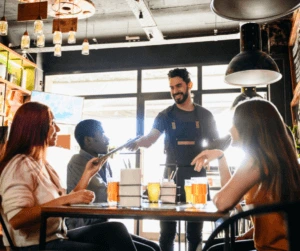Many people begin their days with routines that help set the tone for the day. These small moments, whether it’s getting a cup of coffee at their favorite local shop or stopping by Joe’s Fruit Bar for an energizing fruit smoothie, can help us maintain positive emotional health.
For many people, having the ability to use a loyalty card that gets you one purchase closer to a free drink is an important part of their morning routine. Many loyalty programs are maintained via the store’s app, and you can keep track of your progress at any time.
Then, with your coffee or smoothie in hand, you’re ready to face the day.
The Customer Loyalty Program Trap
These are the types of programs that most people think of when they think about customer loyalty programs. Earn a free cup of coffee or a dinner for two upgrades by completing tasks. Perhaps you’ll be offered an “exclusive” discount.
These programs are expected to achieve specific objectives or tangible measurements of success, according to the brands. The main goal is to keep existing clients and to do it in such a way that it helps the business:
- Maintain revenues, profit margins, and sales levels.
- Increase existing consumers’ loyalty and potential value.
- Encourage existing customers to buy additional products (cross-sell).
Calling out the Pareto Rule
These targeted results are usually associated with certain target sectors, such as heavy purchases or high-net-worth clients. The fundamental assumption is that a tiny percentage of customers account for the majority of a company’s sales and that these clients can be retained indefinitely.
The “80/20 rule” is frequently used by businesses to promote this point of view. According to the 80/20 rule, also known as the Pareto Rule, around 80% of revenue is generated by only 20% of clients. With such a skewed consumer distribution, it seems sensible to focus most marketing resources on the top 20%.
While many customers sign up for these programs and take advantage of the benefits, they aren’t always the primary factor behind repeat business. And, in many situations, the benefits are insufficient to keep individuals interested in the program (or company).
In fact, there is strong evidence that many, if not all, heavy users are multi-brand loyal to a variety of products and services. That is, a company’s most profitable customers are also likely to be the most profitable consumers of its competitors.
Well, so much for brand loyalty!
Bursting the customer loyalty bubble
Despite their popularity, recent studies reveal that loyalty programs are surprisingly ineffective as a standalone or focus strategy.
According to Capgemini, companies spend about $2 billion a year on loyalty programs in the United States alone. Despite this, 77% of reward programs that are solely transactional fail within the first two years.
Some of the most common reasons why loyalty programs fail are listed below:
- The rewards are either unappealing or impossible to obtain.
- Customer data isn’t being exploited to its full potential.
- There are no experiential perks or bonuses in the loyalty program.
- The omnichannel experience is fragmented or absent.
- Customers are unaware of the benefits of your loyalty program.
The bottom line is that customer loyalty programs are complex, resource-intensive, and expensive to maintain.
Needless to say, it’s hard to imagine any business that prioritizes their loyalty members (the 20%) over non-members (as in the 80%) and is still successful. Despite this, many eateries adhere to the Pareto Principle.
The reality is that great customer service, product consistency, and plain old habits may be better predictors of client loyalty.
The effectiveness of loyalty programs
Despite the fact that loyalty programs often pique client attention, they are challenging to justify based on our current understanding of competition and buyer behavior. According to recent studies, the majority of loyalty program schemes do not significantly affect market structure.
To have the best chance of success in difficult market conditions, loyalty programs must increase the overall value of the product or service while also motivating loyal buyers to make their next purchase.
That being said, loyalty programs are but a part of the puzzle and when used properly can really be effective.
Restaurants use and abuse the 80/20 rule because it’s a straightforward way to talk about business. There are numerous cases where it looks that 20% of your clients or processes account for 80% of your success or failure.
The problem with its universal appeal is that after removing the vital 20%, we typically overlook the remaining 80%. That’s a major mistake.
Artificial Intelligence and Machine Learning
As machine learning and AI algorithmic innovation continue to revolutionize analytics, next-generation algorithms are expected to accelerate Pareto’s empirically provocative paradigm.
Here are four major changes that AI and machine learning will bring to how businesses use the Pareto principle to digitally drive profitable innovation beyond traditional analytics.
- Ordering with a Voice Assistant:
With the capabilities of voice assistants constantly developing, it was only a matter of time until restaurants were able to include this capability into their systems. Milagro’s Cloud POS systems have enhanced features that can successfully take Voice orders with the use of automated voice assistants, decreasing the effort required by a customer to place an order. - Improve the customer experience:
AI may be utilized to track client actions in order to provide restaurants with an understanding of how a customer is affected positively or adversely. This can help restaurants create a favorable image of their dedication in the minds of their customers. Restaurants can tremendously benefit from AI to improve their client experience, whether it’s gathering feedback and delivering detailed reports or providing relevant insights into consumer behavior. - Intelligent Reduction in the Costs of Purchasing and Handling Inventories:
Restaurants that integrate AI into their POS systems benefit from detailed analytical data produced by the system that informs management about the utilization of items in their inventory, resulting in significant cost savings. Underutilization or expiration of any product can be avoided by tracking and procuring items based on their use. It also aids in determining whether employees are following the recipes and serving clients the correct portions as determined by the restaurant.
Milagro Cloud POS systems for restaurants
Milagro is an AI-powered restaurant marketing system that creates a personalized profile for each customer and uses their buying history to upsell to them individually and effectively.
Get in touch with us today!
Ready to explore restaurant loyalty app.





